International Trade Report: Openness and Economic Development in Asia
VerifiedAdded on 2023/06/11
|7
|972
|413
Report
AI Summary
This report delves into the realm of international trade, utilizing the trade-to-GDP ratio as a measure of globalization, specifically focusing on Malaysia and Singapore. It examines the shifts in trade openness over time, revealing that while Singapore exhibits higher overall openness, Malaysia has experienced more rapid growth in this area, particularly since the 1990s. The report further explores the correlation between trade openness and economic development, indicating a positive relationship where increased openness often leads to higher economic growth, as supported by Heckscher-Ohlin theory. Finally, it identifies governmental policies, industrialization, and foreign investment as key drivers of trade openness in both countries, highlighting their impact on capital formation, export growth, and overall economic performance. The report concludes by referencing several academic sources to support its findings.
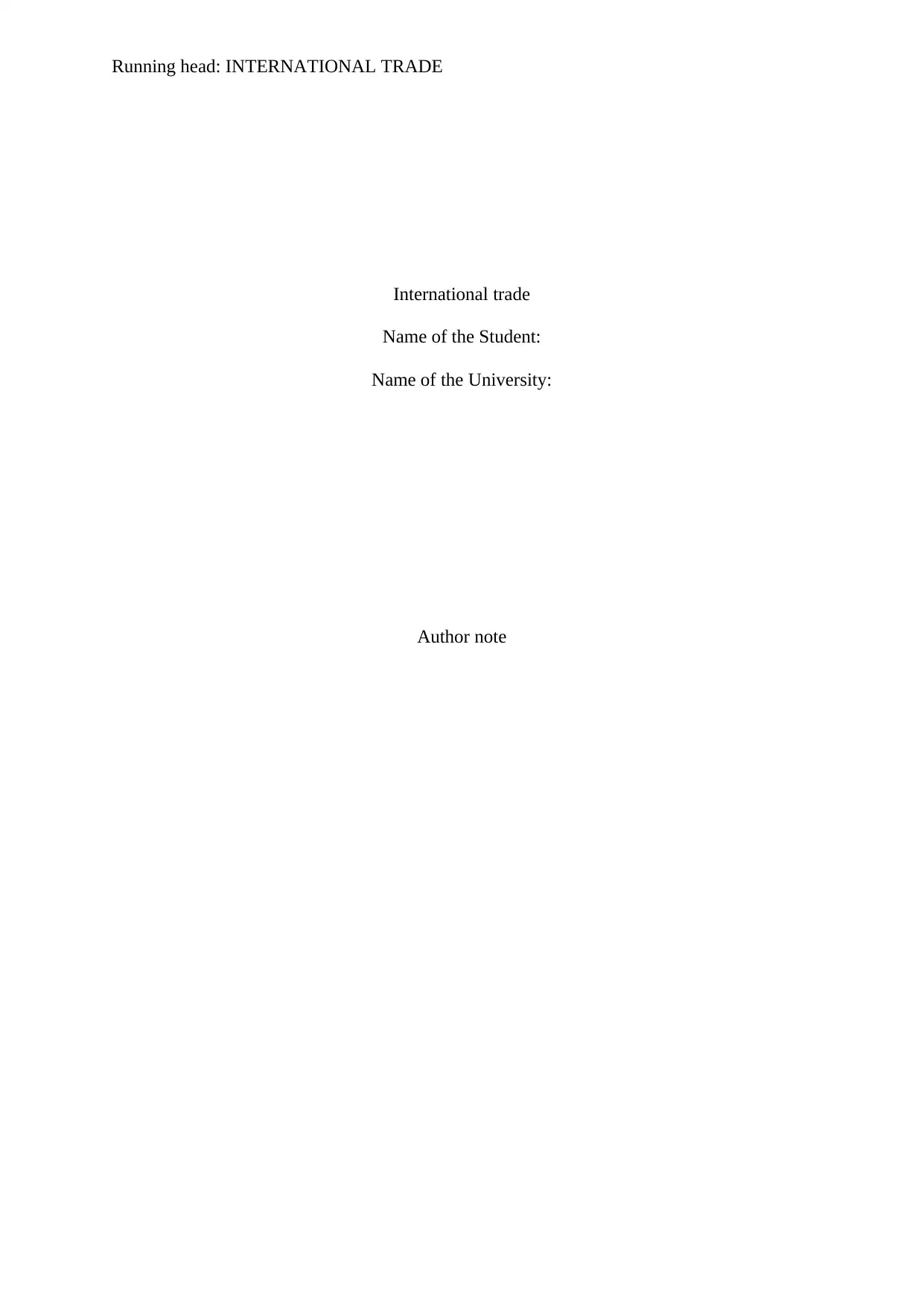
Running head: INTERNATIONAL TRADE
International trade
Name of the Student:
Name of the University:
Author note
International trade
Name of the Student:
Name of the University:
Author note
Paraphrase This Document
Need a fresh take? Get an instant paraphrase of this document with our AI Paraphraser
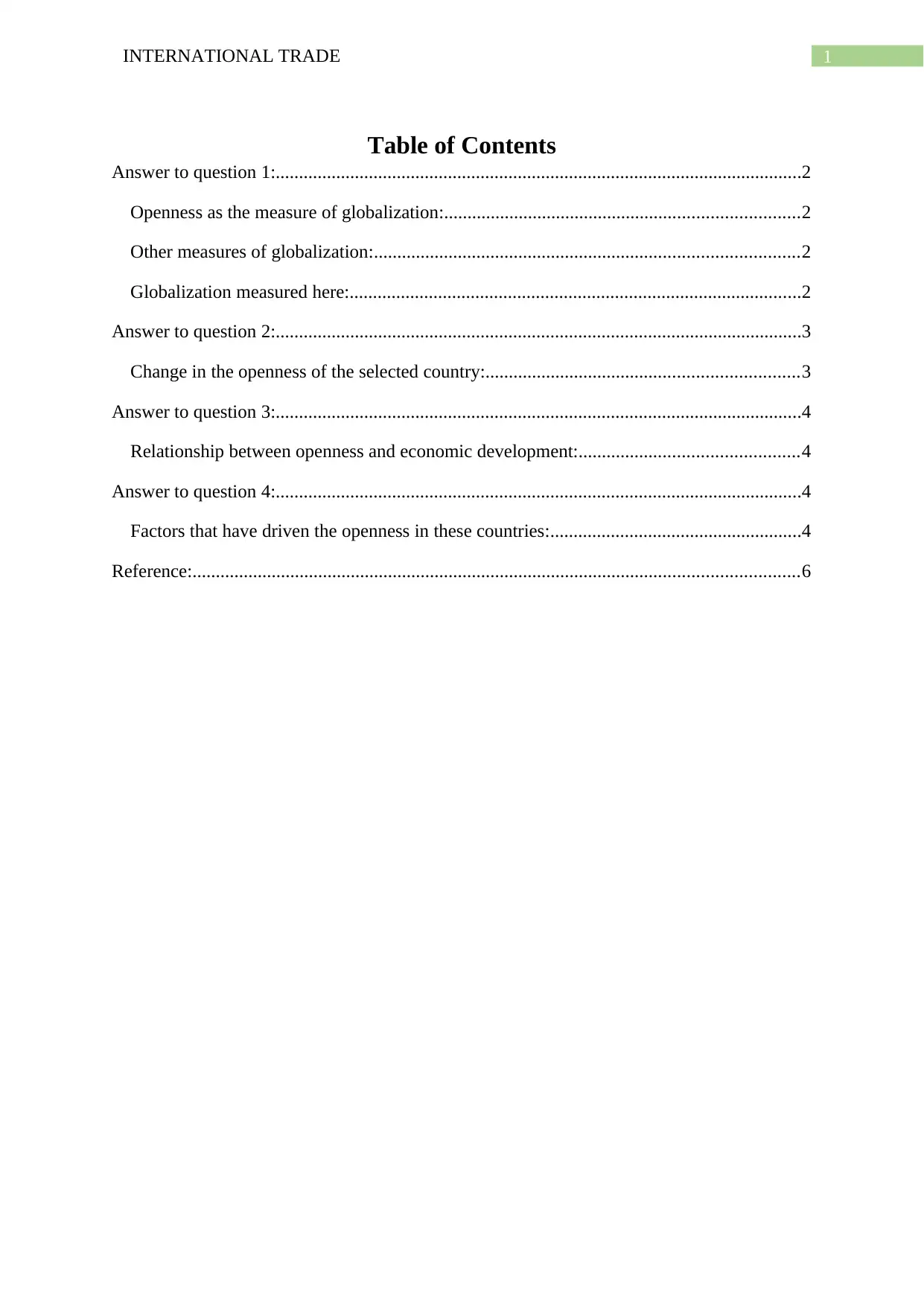
1INTERNATIONAL TRADE
Table of Contents
Answer to question 1:.................................................................................................................2
Openness as the measure of globalization:............................................................................2
Other measures of globalization:...........................................................................................2
Globalization measured here:.................................................................................................2
Answer to question 2:.................................................................................................................3
Change in the openness of the selected country:...................................................................3
Answer to question 3:.................................................................................................................4
Relationship between openness and economic development:...............................................4
Answer to question 4:.................................................................................................................4
Factors that have driven the openness in these countries:......................................................4
Reference:..................................................................................................................................6
Table of Contents
Answer to question 1:.................................................................................................................2
Openness as the measure of globalization:............................................................................2
Other measures of globalization:...........................................................................................2
Globalization measured here:.................................................................................................2
Answer to question 2:.................................................................................................................3
Change in the openness of the selected country:...................................................................3
Answer to question 3:.................................................................................................................4
Relationship between openness and economic development:...............................................4
Answer to question 4:.................................................................................................................4
Factors that have driven the openness in these countries:......................................................4
Reference:..................................................................................................................................6
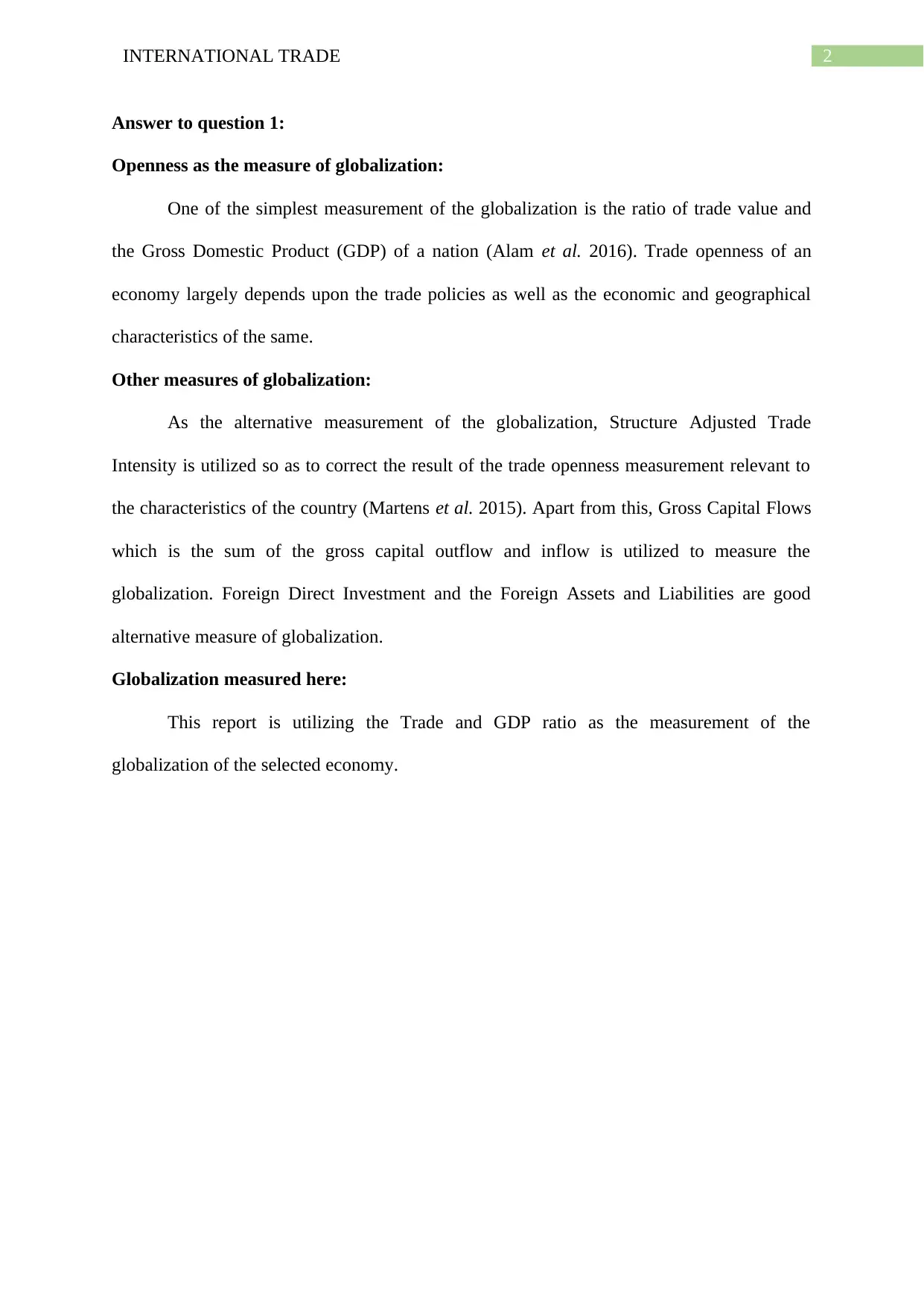
2INTERNATIONAL TRADE
Answer to question 1:
Openness as the measure of globalization:
One of the simplest measurement of the globalization is the ratio of trade value and
the Gross Domestic Product (GDP) of a nation (Alam et al. 2016). Trade openness of an
economy largely depends upon the trade policies as well as the economic and geographical
characteristics of the same.
Other measures of globalization:
As the alternative measurement of the globalization, Structure Adjusted Trade
Intensity is utilized so as to correct the result of the trade openness measurement relevant to
the characteristics of the country (Martens et al. 2015). Apart from this, Gross Capital Flows
which is the sum of the gross capital outflow and inflow is utilized to measure the
globalization. Foreign Direct Investment and the Foreign Assets and Liabilities are good
alternative measure of globalization.
Globalization measured here:
This report is utilizing the Trade and GDP ratio as the measurement of the
globalization of the selected economy.
Answer to question 1:
Openness as the measure of globalization:
One of the simplest measurement of the globalization is the ratio of trade value and
the Gross Domestic Product (GDP) of a nation (Alam et al. 2016). Trade openness of an
economy largely depends upon the trade policies as well as the economic and geographical
characteristics of the same.
Other measures of globalization:
As the alternative measurement of the globalization, Structure Adjusted Trade
Intensity is utilized so as to correct the result of the trade openness measurement relevant to
the characteristics of the country (Martens et al. 2015). Apart from this, Gross Capital Flows
which is the sum of the gross capital outflow and inflow is utilized to measure the
globalization. Foreign Direct Investment and the Foreign Assets and Liabilities are good
alternative measure of globalization.
Globalization measured here:
This report is utilizing the Trade and GDP ratio as the measurement of the
globalization of the selected economy.
⊘ This is a preview!⊘
Do you want full access?
Subscribe today to unlock all pages.

Trusted by 1+ million students worldwide
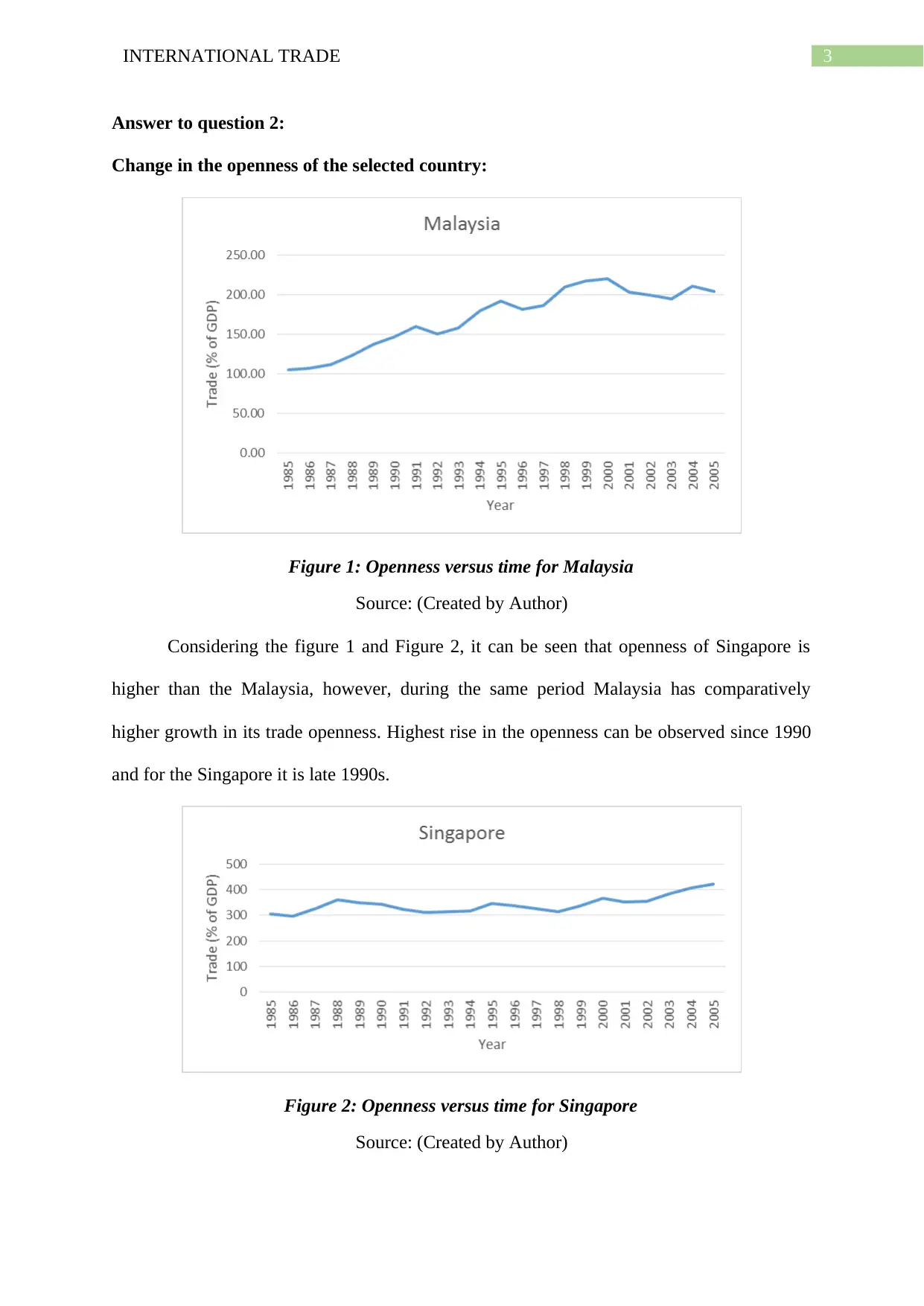
3INTERNATIONAL TRADE
Answer to question 2:
Change in the openness of the selected country:
Figure 1: Openness versus time for Malaysia
Source: (Created by Author)
Considering the figure 1 and Figure 2, it can be seen that openness of Singapore is
higher than the Malaysia, however, during the same period Malaysia has comparatively
higher growth in its trade openness. Highest rise in the openness can be observed since 1990
and for the Singapore it is late 1990s.
Figure 2: Openness versus time for Singapore
Source: (Created by Author)
Answer to question 2:
Change in the openness of the selected country:
Figure 1: Openness versus time for Malaysia
Source: (Created by Author)
Considering the figure 1 and Figure 2, it can be seen that openness of Singapore is
higher than the Malaysia, however, during the same period Malaysia has comparatively
higher growth in its trade openness. Highest rise in the openness can be observed since 1990
and for the Singapore it is late 1990s.
Figure 2: Openness versus time for Singapore
Source: (Created by Author)
Paraphrase This Document
Need a fresh take? Get an instant paraphrase of this document with our AI Paraphraser
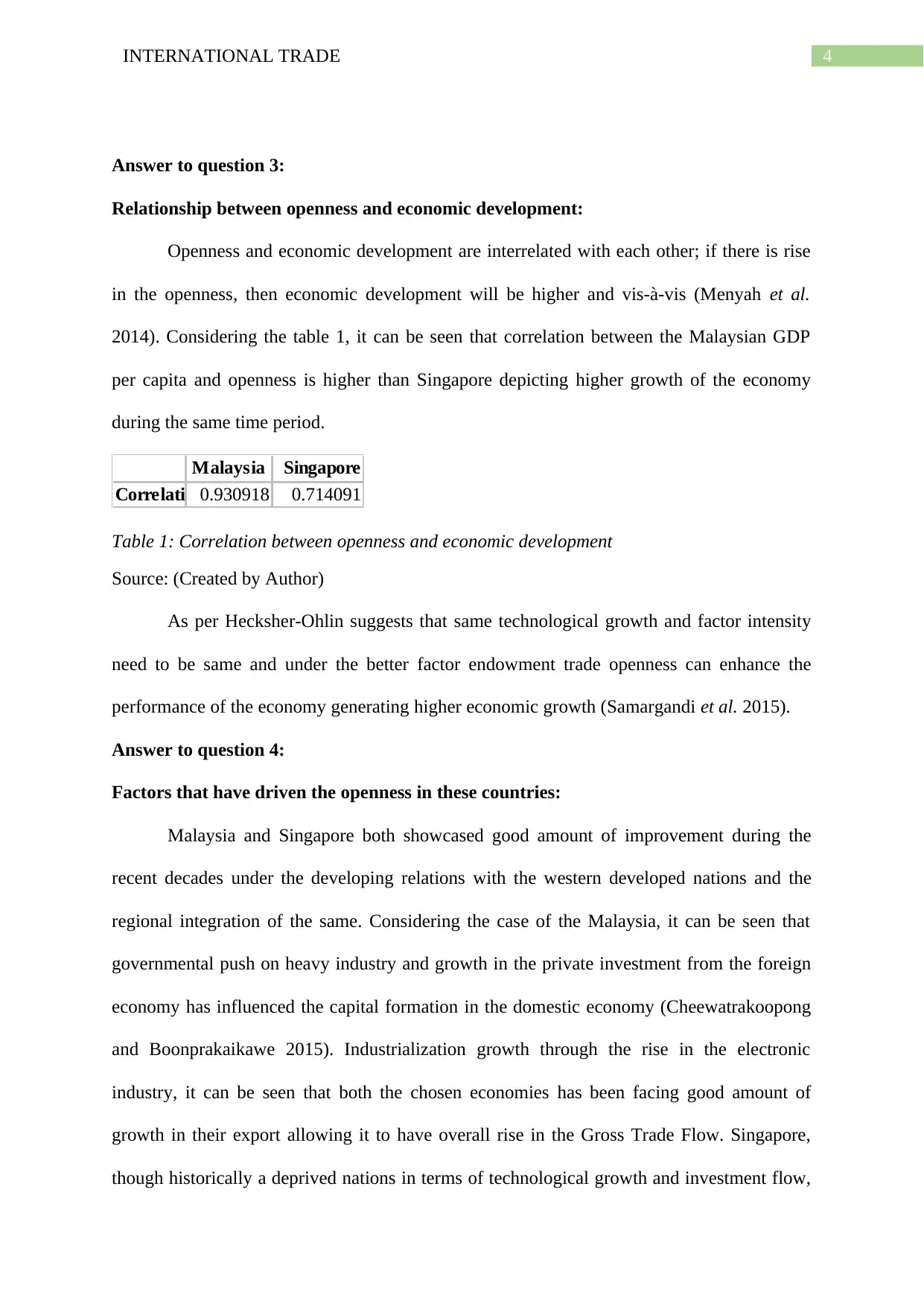
4INTERNATIONAL TRADE
Answer to question 3:
Relationship between openness and economic development:
Openness and economic development are interrelated with each other; if there is rise
in the openness, then economic development will be higher and vis-à-vis (Menyah et al.
2014). Considering the table 1, it can be seen that correlation between the Malaysian GDP
per capita and openness is higher than Singapore depicting higher growth of the economy
during the same time period.
Malaysia Singapore
Correlation0.930918 0.714091
Table 1: Correlation between openness and economic development
Source: (Created by Author)
As per Hecksher-Ohlin suggests that same technological growth and factor intensity
need to be same and under the better factor endowment trade openness can enhance the
performance of the economy generating higher economic growth (Samargandi et al. 2015).
Answer to question 4:
Factors that have driven the openness in these countries:
Malaysia and Singapore both showcased good amount of improvement during the
recent decades under the developing relations with the western developed nations and the
regional integration of the same. Considering the case of the Malaysia, it can be seen that
governmental push on heavy industry and growth in the private investment from the foreign
economy has influenced the capital formation in the domestic economy (Cheewatrakoopong
and Boonprakaikawe 2015). Industrialization growth through the rise in the electronic
industry, it can be seen that both the chosen economies has been facing good amount of
growth in their export allowing it to have overall rise in the Gross Trade Flow. Singapore,
though historically a deprived nations in terms of technological growth and investment flow,
Answer to question 3:
Relationship between openness and economic development:
Openness and economic development are interrelated with each other; if there is rise
in the openness, then economic development will be higher and vis-à-vis (Menyah et al.
2014). Considering the table 1, it can be seen that correlation between the Malaysian GDP
per capita and openness is higher than Singapore depicting higher growth of the economy
during the same time period.
Malaysia Singapore
Correlation0.930918 0.714091
Table 1: Correlation between openness and economic development
Source: (Created by Author)
As per Hecksher-Ohlin suggests that same technological growth and factor intensity
need to be same and under the better factor endowment trade openness can enhance the
performance of the economy generating higher economic growth (Samargandi et al. 2015).
Answer to question 4:
Factors that have driven the openness in these countries:
Malaysia and Singapore both showcased good amount of improvement during the
recent decades under the developing relations with the western developed nations and the
regional integration of the same. Considering the case of the Malaysia, it can be seen that
governmental push on heavy industry and growth in the private investment from the foreign
economy has influenced the capital formation in the domestic economy (Cheewatrakoopong
and Boonprakaikawe 2015). Industrialization growth through the rise in the electronic
industry, it can be seen that both the chosen economies has been facing good amount of
growth in their export allowing it to have overall rise in the Gross Trade Flow. Singapore,
though historically a deprived nations in terms of technological growth and investment flow,
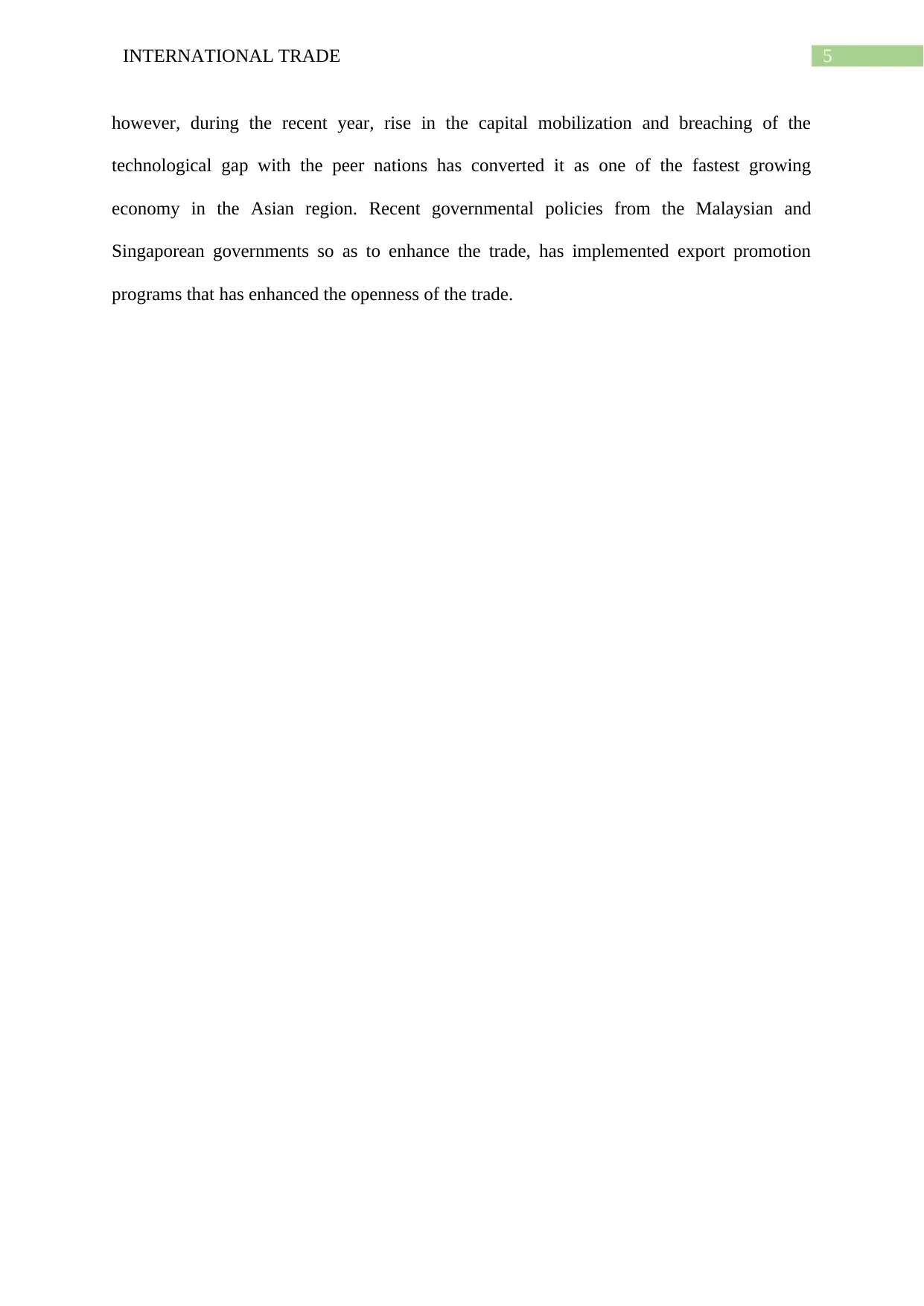
5INTERNATIONAL TRADE
however, during the recent year, rise in the capital mobilization and breaching of the
technological gap with the peer nations has converted it as one of the fastest growing
economy in the Asian region. Recent governmental policies from the Malaysian and
Singaporean governments so as to enhance the trade, has implemented export promotion
programs that has enhanced the openness of the trade.
however, during the recent year, rise in the capital mobilization and breaching of the
technological gap with the peer nations has converted it as one of the fastest growing
economy in the Asian region. Recent governmental policies from the Malaysian and
Singaporean governments so as to enhance the trade, has implemented export promotion
programs that has enhanced the openness of the trade.
⊘ This is a preview!⊘
Do you want full access?
Subscribe today to unlock all pages.

Trusted by 1+ million students worldwide
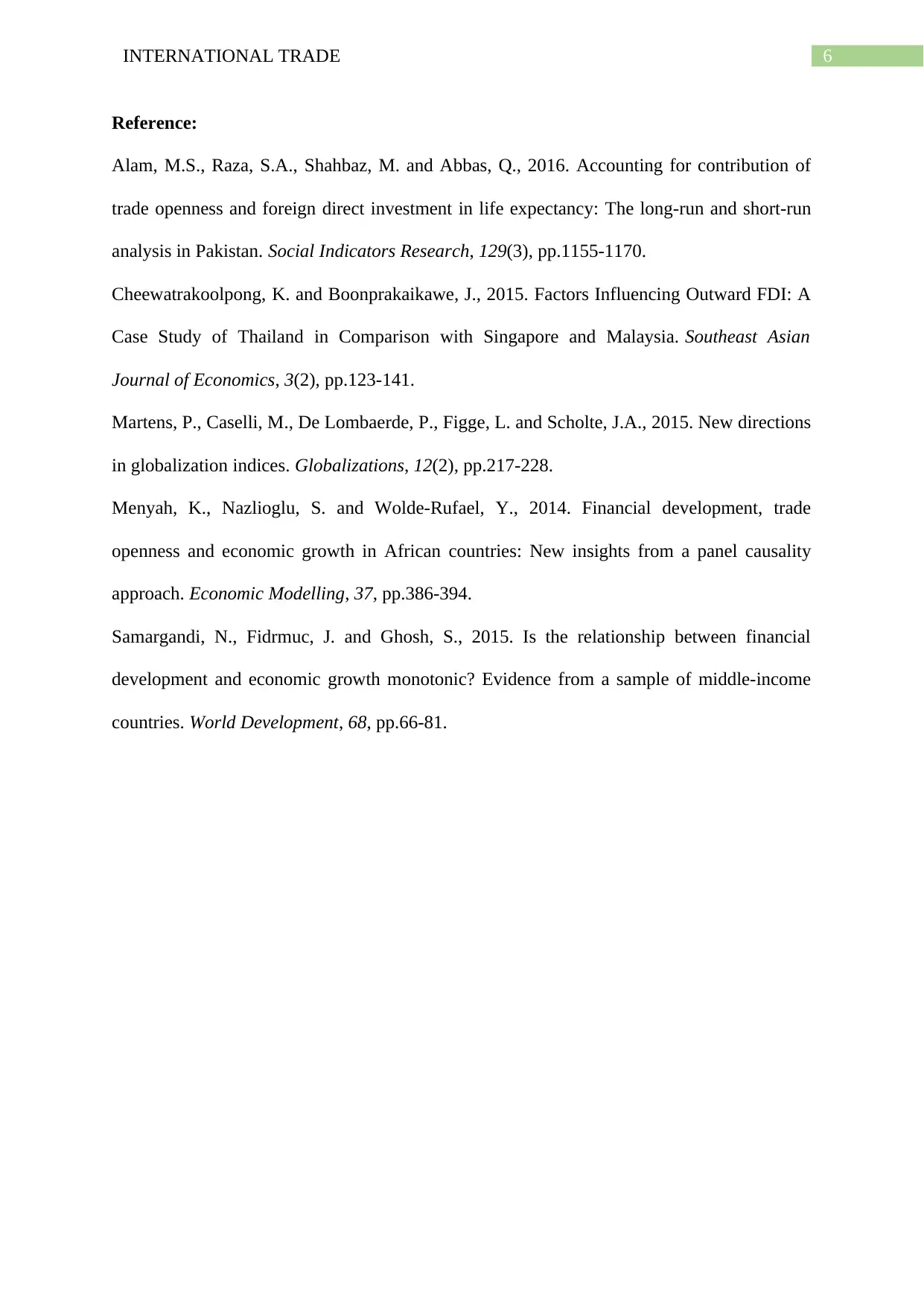
6INTERNATIONAL TRADE
Reference:
Alam, M.S., Raza, S.A., Shahbaz, M. and Abbas, Q., 2016. Accounting for contribution of
trade openness and foreign direct investment in life expectancy: The long-run and short-run
analysis in Pakistan. Social Indicators Research, 129(3), pp.1155-1170.
Cheewatrakoolpong, K. and Boonprakaikawe, J., 2015. Factors Influencing Outward FDI: A
Case Study of Thailand in Comparison with Singapore and Malaysia. Southeast Asian
Journal of Economics, 3(2), pp.123-141.
Martens, P., Caselli, M., De Lombaerde, P., Figge, L. and Scholte, J.A., 2015. New directions
in globalization indices. Globalizations, 12(2), pp.217-228.
Menyah, K., Nazlioglu, S. and Wolde-Rufael, Y., 2014. Financial development, trade
openness and economic growth in African countries: New insights from a panel causality
approach. Economic Modelling, 37, pp.386-394.
Samargandi, N., Fidrmuc, J. and Ghosh, S., 2015. Is the relationship between financial
development and economic growth monotonic? Evidence from a sample of middle-income
countries. World Development, 68, pp.66-81.
Reference:
Alam, M.S., Raza, S.A., Shahbaz, M. and Abbas, Q., 2016. Accounting for contribution of
trade openness and foreign direct investment in life expectancy: The long-run and short-run
analysis in Pakistan. Social Indicators Research, 129(3), pp.1155-1170.
Cheewatrakoolpong, K. and Boonprakaikawe, J., 2015. Factors Influencing Outward FDI: A
Case Study of Thailand in Comparison with Singapore and Malaysia. Southeast Asian
Journal of Economics, 3(2), pp.123-141.
Martens, P., Caselli, M., De Lombaerde, P., Figge, L. and Scholte, J.A., 2015. New directions
in globalization indices. Globalizations, 12(2), pp.217-228.
Menyah, K., Nazlioglu, S. and Wolde-Rufael, Y., 2014. Financial development, trade
openness and economic growth in African countries: New insights from a panel causality
approach. Economic Modelling, 37, pp.386-394.
Samargandi, N., Fidrmuc, J. and Ghosh, S., 2015. Is the relationship between financial
development and economic growth monotonic? Evidence from a sample of middle-income
countries. World Development, 68, pp.66-81.
1 out of 7
Related Documents
Your All-in-One AI-Powered Toolkit for Academic Success.
+13062052269
info@desklib.com
Available 24*7 on WhatsApp / Email
![[object Object]](/_next/static/media/star-bottom.7253800d.svg)
Unlock your academic potential
Copyright © 2020–2025 A2Z Services. All Rights Reserved. Developed and managed by ZUCOL.





